Since the inception of the Egyptian Premier League in 1948, Al Ahly have displayed a spectacular level of dominance. They have won 42 league titles, 37 Egypt Cups, 12 Egyptian Super Cups. This show of authority is not purely on the domestic stage, it extends to a continental level as Al Ahly are the holders of a record 10 CAF Champions League titles.
The 2019/20 season was the last time that Al Ahly lifted the Egyptian Premier League title, they also won the CAF Champions League that year and retained it a year later. The league campaign in 2020/21 saw Al Ahly finish second. The following season, they finished third. This was the first time they had finished outside the top 2 since 1992. To add to the bitter disappointment, rivals Zamalek won the title on both occasions. In August 2022, then-manager Ricardo Soares was relieved of his post having not only failed to reclaim the league title from Zamalek but also losing to them in the Egypt Cup Final.
The man charged with restoring Al Ahly back to their best? Marcel Koller. The 62-year-old was part of the legendary Zurich Grasshoppers team throughout the eighties and nineties. Since retiring in ‘97, Koller has made a name for himself in management which has seen him at the helm of various clubs in his native Switzerland and Germany, including a four-year stint at Vfl Bochum in the Bundesliga.
From 2011-2017 Koller enjoyed a stint as manager of the Austrian national team where he guided the team to qualification for the 2016 European Championships (their only previous qualification coming in 2008 as hosts). Under Koller’s guidance, the Austrian national team rose to tenth in the FIFA World Rankings – its highest-ever position.
After a spell in charge of Basel, Koller has taken on the task of bringing success back to Egypt and Africa’s most successful club. So far, he has enjoyed quite a brilliant start. Al Ahly are top of the league and remain unbeaten with 12 wins and five draws. Having conceded only six goals in 17 games, the Al Ahly defence looks to be impenetrable.
Al Ahly recently took part in the FIFA Club World Cup where they enjoyed first and second-round victories against New Zealand outfit Auckland City and MLS side Seattle Sounders. The semi-final against footballing giants Real Madrid proved to be too much as the Egyptian side were beaten 4-1.
This tactical analysis will dissect the tactics that Marcel Koller has used to ensure that the Egyptian club return to the top. This analysis will show how Koller sets his team up both in the attacking and defensive phases and how they carry out his tactics.
Preferred formations

Koller primarily sets his team up in a 4-2-3-1 formation. This formation provides a good balance between attack and defence as the two defensive midfielders provide cover for the backline. This can help to control possession, break up opposition attacks, and initiate counterattacks.
This particular tactical setup is popular as it lends itself to suit different styles of play. The attacking midfielder can play as a central playmaker or as a wide forward, while the full-backs can provide width in attack or drop back to defend.
It can be very effective in implementing a high-pressing style of play. The attacking players can press the opposition high up the pitch, while the two defensive midfielders can cut off passing lanes and win back possession quickly.
The 4-2-3-1 formation also allows for a strong attacking presence with four players in advanced positions. This can create more goal-scoring opportunities and put pressure on the opposition’s defence.
Data analysis
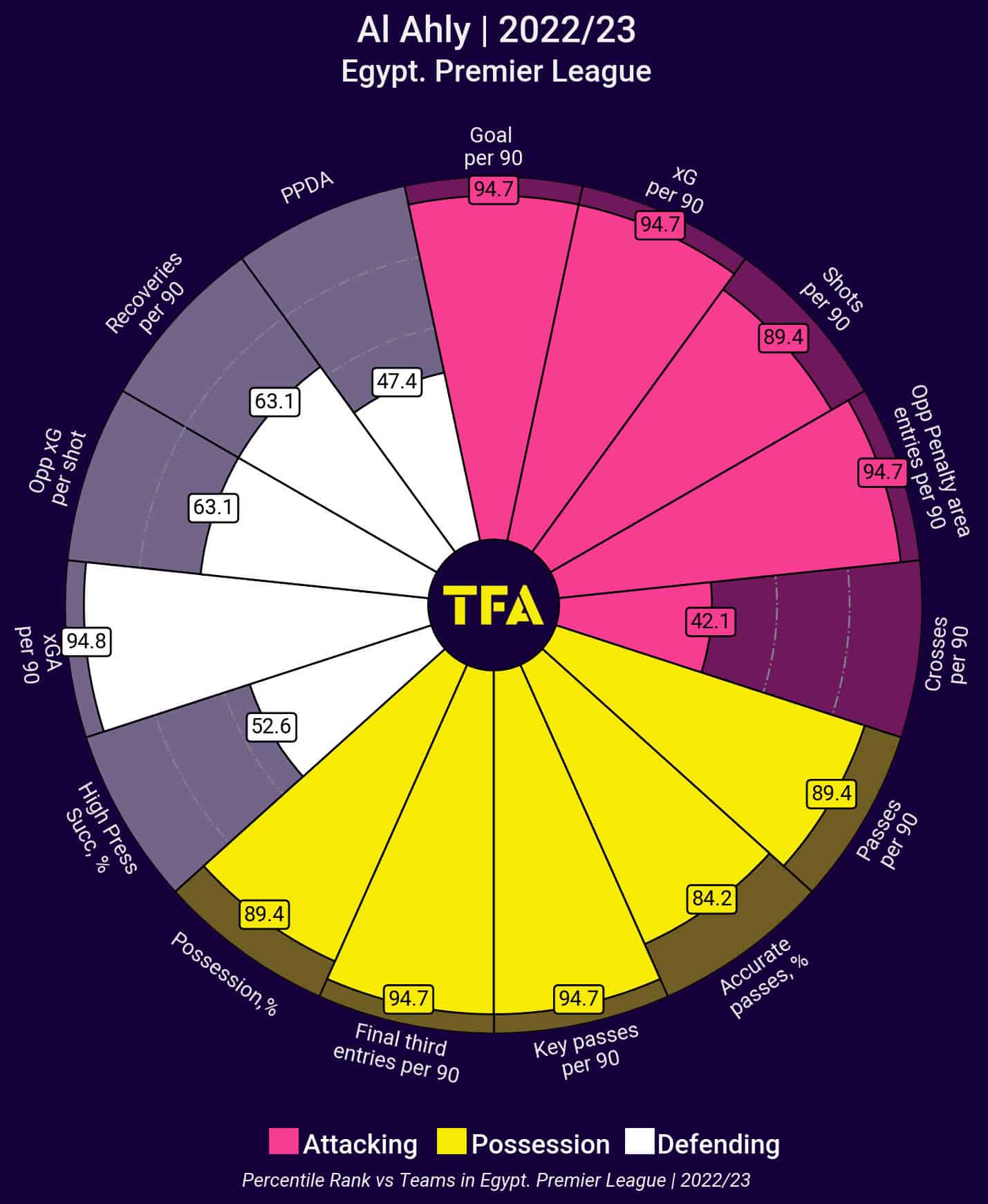
The pizza chart above is a good way of generating a brief overview of Koller’s tactics at Al Ahly before moving on to a more in-depth tactical analysis. The data viz shows that Koller’s team are possession-based as they are in the 89th percentile due to their possession stats.
The fact that Al Ahly appears to be in the 42nd percentile for the number of crosses per 90 suggests that Koller’s tactics are not solely structured around crossing into the box from wide areas. This infers that the Egyptian giants look to work the ball into the penalty area, possibly utilising the half spaces for any crossing opportunities.
As expected for a team that looks to control the ball, Al Ahly rank lower in the defensive areas of the game. They do not complete many ball recoveries per game due to the fact that they are mostly in possession. Therefore, they are required to execute fewer defensive actions.
Their goal output is high, they have scored 30 goals in 17 league games so far this season which is the most in the Egyptian Premier League. As mentioned previously, Al Ahly have only conceded six goals this campaign which indicates that they have a strong defensive structure as the foundation of Koller’s tactical setup.
Off-the-ball movement
When building an attack, Marcel Koller’s 4-2-3-1 formation looks more akin to a 4-2-4 with the four attacking players occupying the opposition backline. This then allows for the opportunity to either play a pass in behind the opposition’s defence as there are four runners ready to charge into the space or provide a chance for the midfielders to join the attack. As the four defenders are already occupied with the Al Ahly attackers, any midfield runners will need to be tracked by the opponent’s midfielders which is a way of dragging them out of position and creating space.
The images below show how Koller likes to use off-the-ball movements when building an attack from the back. Al Ahly average 35.33 positional attacks per 90 this season, they also average 55% possession, indicating they like to keep hold of the ball to maintain their attacking style.
As shown below, the centre-back is receiving possession, the two midfield players then make a forward run whilst the player occupying the right-back position moves into the central midfield area and the right winger drops a little deeper to close the gap between the defence and attack.
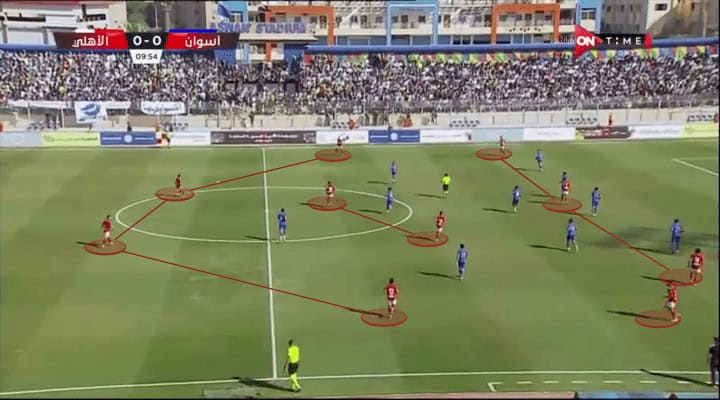
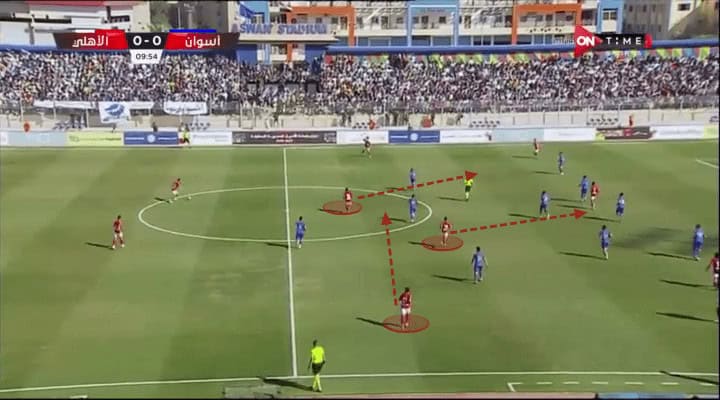
The central area is key to Koller’s tactic as it is where the transition between defence and attack often occurs. It is primarily Aliou Dieng paired with either Marwan Ateya or Hamdi Fathi. Dieng averages 10.18 progressive passes per 90 while Ateya averages 10.75. The image below showcases how the player occupying the central area in midfield is in a good position to then play a pass to transition the play into the attacking phase or play a safer pass back to a defender.
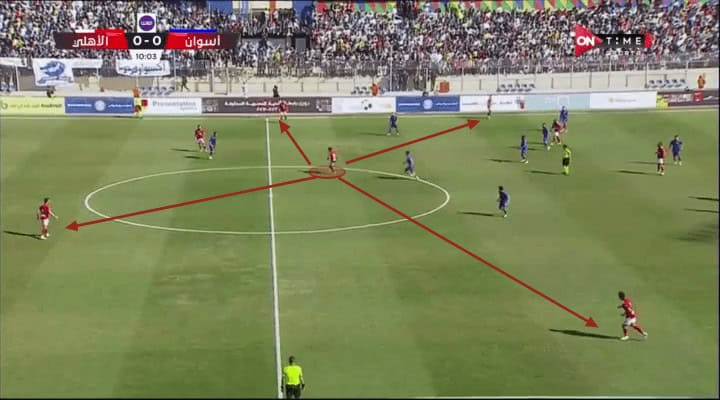
Playing through the lines
Under Koller’s leadership, Al Ahly often look to play through the lines of their opponents. This is an excellent way of using the off-the-ball movements that the former Austria manager is keen to see from his players. As the data visual below indicates, they often play progressive passes from wide areas or the half-spaces, though Al Ahly are also not averse to playing straight through the middle should an opportunity appear.
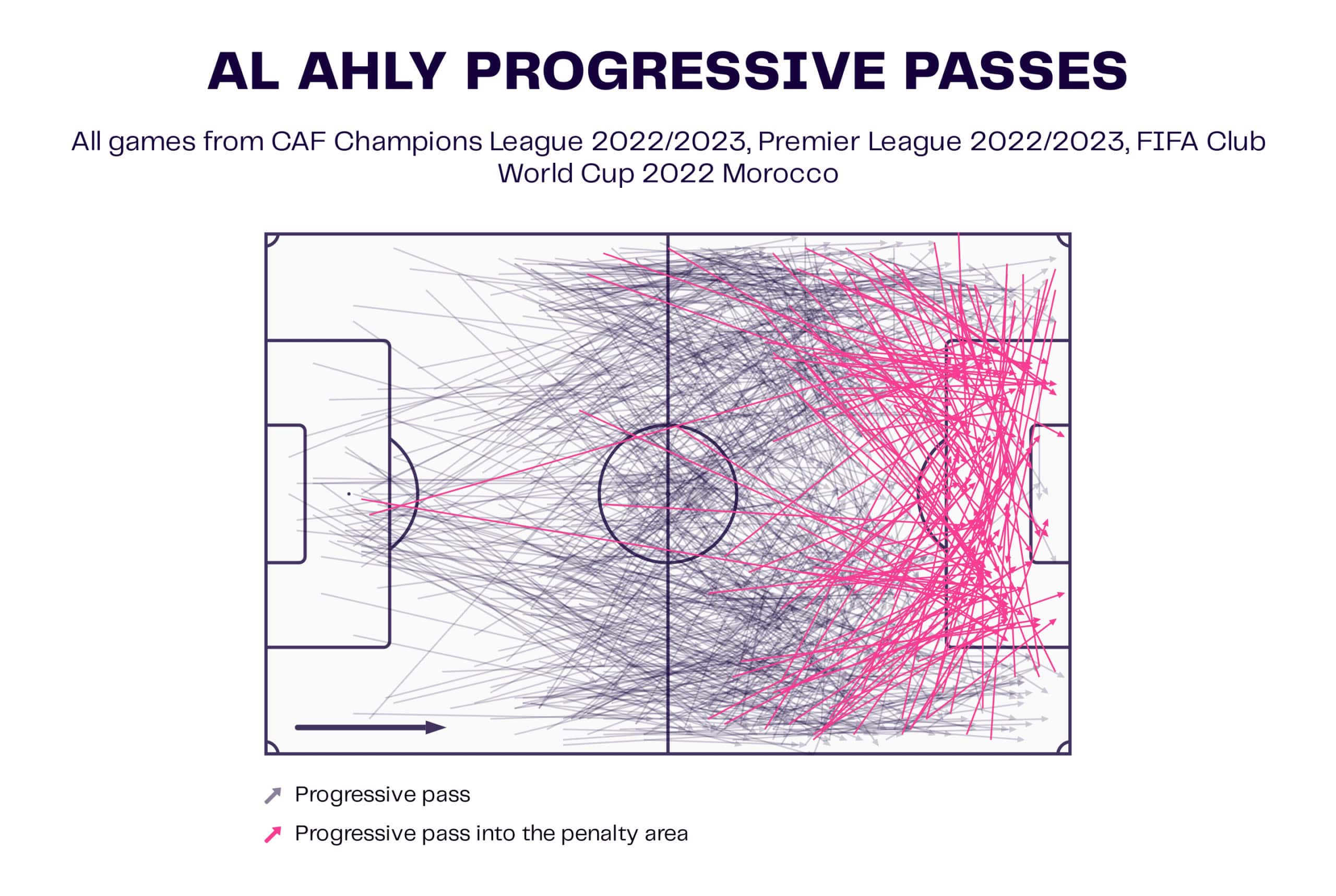
Al Ahly often use quick layoffs and third-man runs to play through the opposition lines. As shown in the image below, Dieng is in possession and plays a pass to the right back who is highlighted on the wing. He then lays it off to the attacking midfielder who has made a third-man run. This simple move completely bypasses the opposition press and quickly ensures that Al Ahly are on the attack.
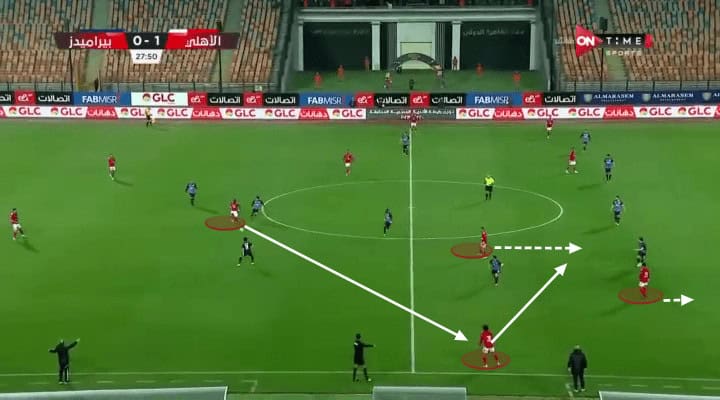
As mentioned above, the Egyptian giants will attack through the middle should the opportunity present itself. As depicted in the images below, Al Ahly are in possession of the ball and have the four attackers sitting incredibly narrow whilst the left-back has also pushed up to join the attack and is also very narrow, with the right-back staying wide to create the width.
Whilst the most obvious available pass would be to the left back, the player in possession opts to play a pass to one of the attackers who has found space in between the defenders. This allows the attacker to roll the defender closest to him and quickly generate a shot at goal.
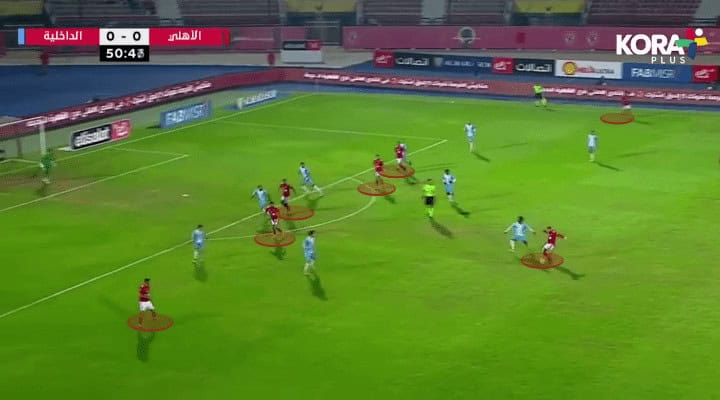
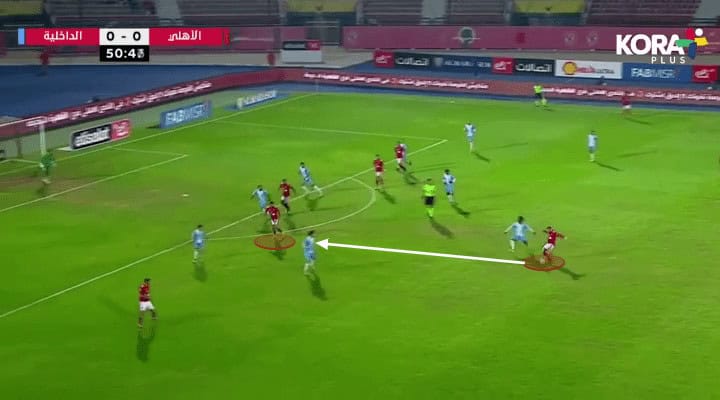
The image below is another demonstration of Al Ahly attacking through the middle. On this occasion, the ball will be played into the attacker who is cutting in from the right side. In one pass, the opposition defence is taken out of the game and Al Ahly are presented with a great scoring opportunity.
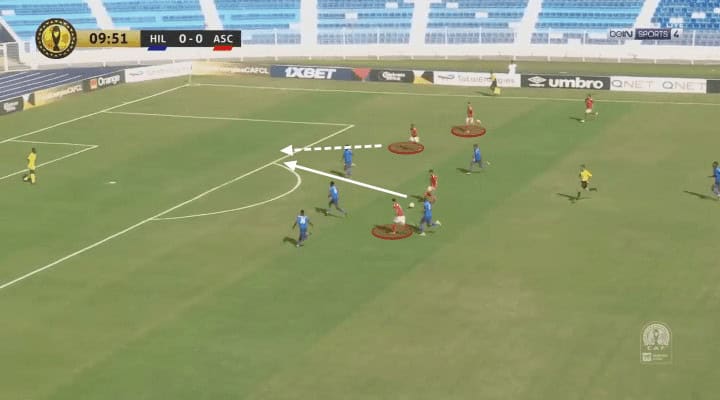
When they receive the ball in wide areas, under Koller’s tactical direction, Al Ahly don’t look to attack down the wings. Instead, the wide players look to play a pass in behind the opposition’s defensive line.
As shown in the first image below, there are three Al Ahly players making forward. The right-back has plenty of space behind the defensive line to aim his pass into which will provide the attackers with the opportunity to run onto the pass and go 1v1 with the goalkeeper.
The second image showcases a similar scenario. This time on the left side of the pitch, the left back is in possession and there are four attacking players looking to run behind the defensive line. In the image, Percy Tau is the furthest player forward and has his arm aloft indicating he wants the ball played. A relatively simple ball over the top of the defence will see him be presented with a 1v1 against the keeper.
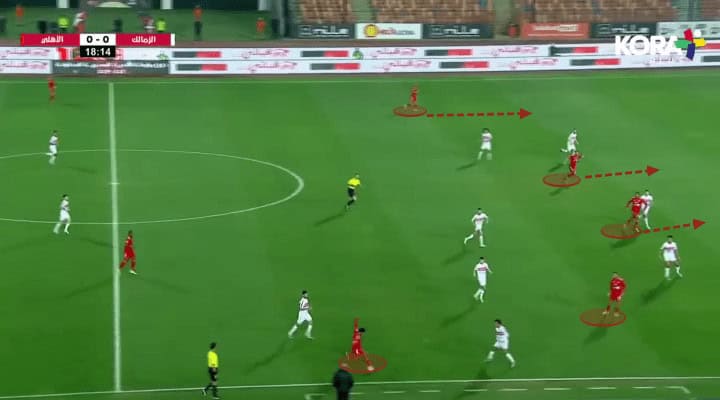
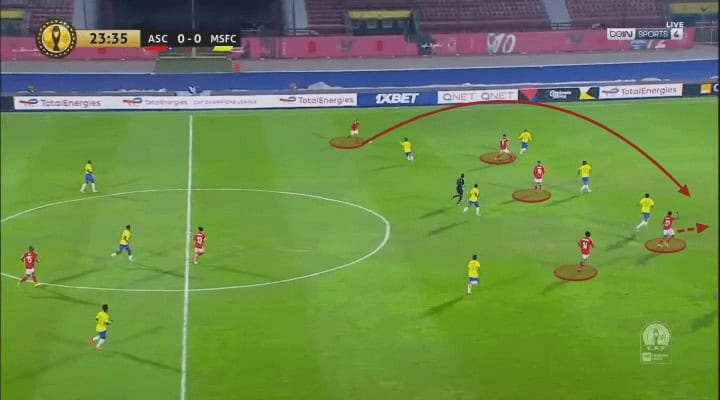
High pressing
Having dissected Al Ahly’s play within the attacking phase, this section of the tactical analysis will focus on the defensive phase:
Marcel Koller uses a 4-2-3-1 formation which lends itself to pressing high up the pitch in order to regain possession and catch the opponent out of position. The data visualisation below shows the defensive territory of Al Ahly. The average position of the defensive line is high which is what ensures the forwards and midfielders are able to engage in a counter-press when possession has been lost.
Al Ahly also frequently demonstrate excellent defensive positioning as the viz shows, they average 39.67 interceptions per 90, indicating the players are able to position themselves in the right areas to cut off the passing lanes.

Al Ahly look to engage in a counter press immediately after ceding possession. As the data viz demonstrates, they have completed 410 counter-pressing recoveries and 271 high regains, recovering possession in the attacking third.
By pressing the opposition players when they have the ball, it can prevent them from building up attacks and getting into dangerous positions on the field. This can force them to make mistakes, lose possession or play long balls which can be easily intercepted.
If the press is instigated consistently and effectively, it can tire out the opposition players, making them less effective as the game progresses. Effective pressing is beneficial not just in a footballing sense, it can have a positive effect on team morale as it shows that the team is playing with a high level of intensity and determination to win the ball back.
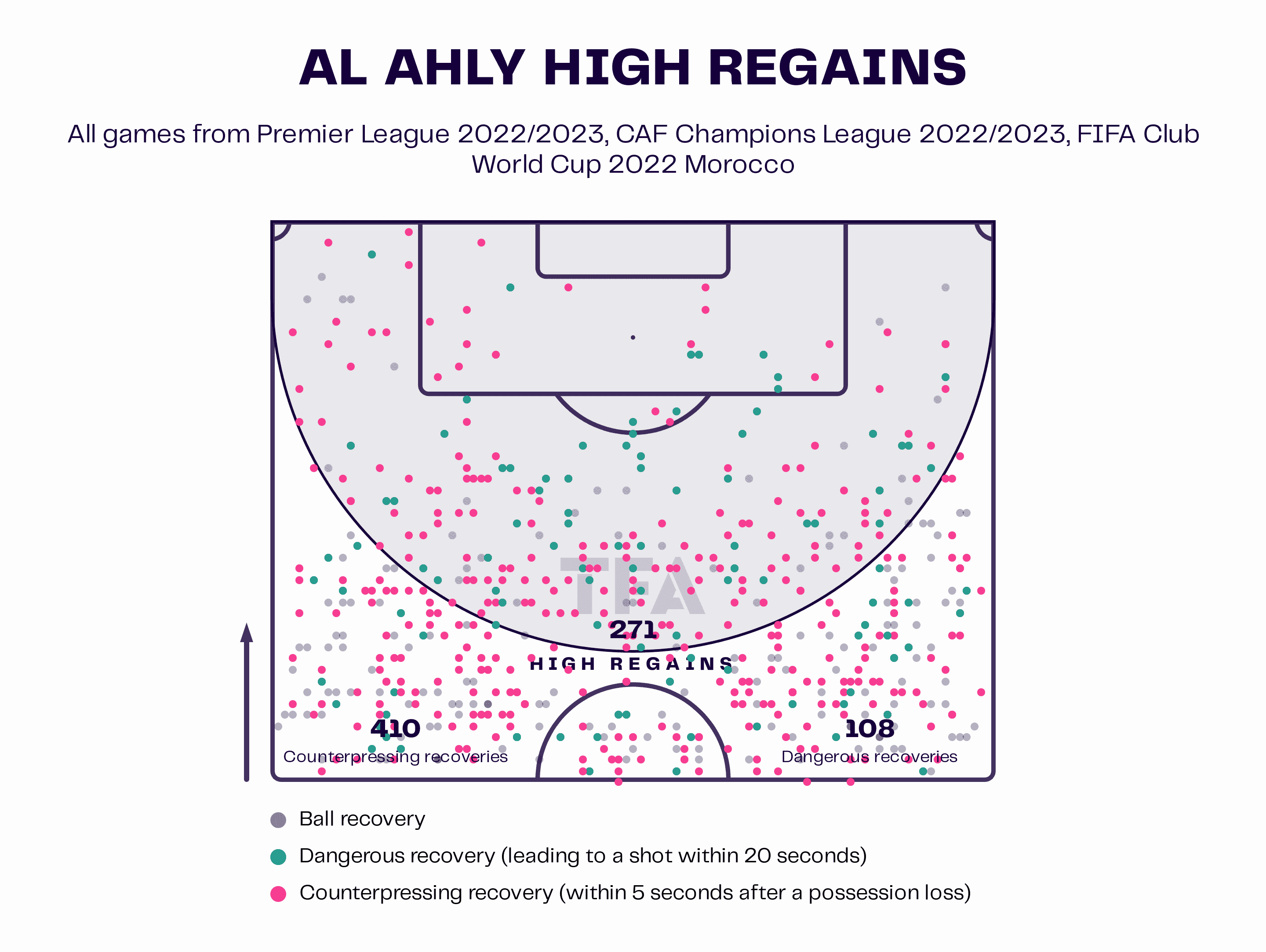
The images below are a prime example of the Al Ahly counter-press in action. With the opposition looking to transition from defence to attack, the Al Ahly players initiate a counter-press. Collectively, they ensure that they are all in the correct position to win the ball back and then launch a counterattack.
In the images below, the midfielder is pressing the opponent player in possession. He is able to retrieve possession and then play a pass through to the winger who can create a goal-scoring opportunity.
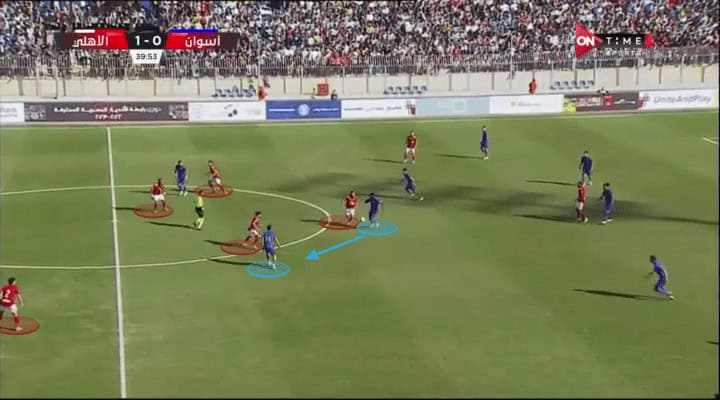
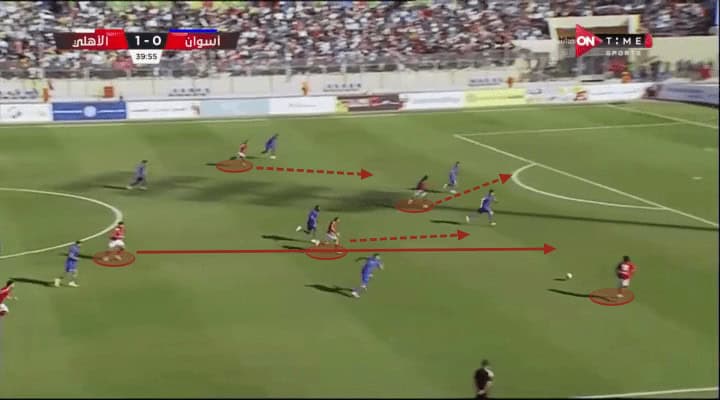
Furthermore, the image below shows Al Ahly engaging in their press before the opposition has had a chance to initiate any sort of attacking play. The Al Ahly players have pinned their opponents into an incredibly difficult position to play out from. They are cutting off the passing lanes which increases the likelihood of the opposition having to go long which could be more easily intercepted.
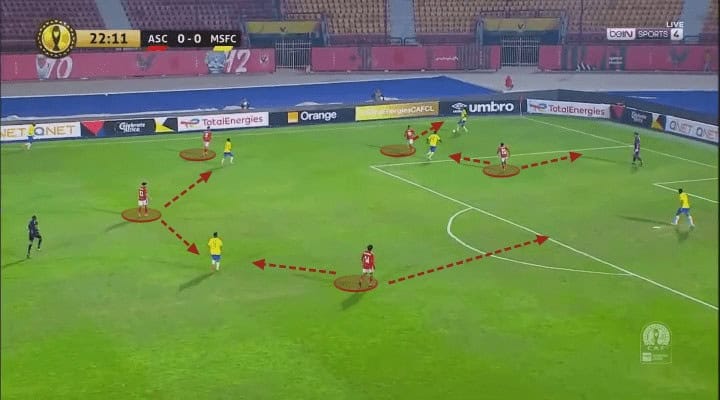
Functionality
There are occasions when the Al Ahly defence adopts a more functional approach. As the image below demonstrates, there are eight Al Ahly players in close proximity to the ball. This boxes the Zamalek players in and offers them no way of playing out. Compared with the more structured build-up play, this is purely about functionality – taking action to win the ball back. It also shows how important pressing is to the Al Ahly tactical system and how it is the key element to their play within the defensive phase.

However, there can be issues with Al Ahly’s play during the transition from attack to defence and then into the defensive phase. The sequence of images shows how some of the choices made by the players when defending can cause problems and offer potential goalscoring opportunities to the opposition.
In the first image, Al Ahly have lost possession and are in the transition from attack to defence. The four defenders are highlighted. The previous attack was taking place down Al Ahly’s left side so the left back had pushed up to support the attack.
The right-back is moving over to provide cover alongside the two centre-backs which is not unexpected. This does, however, leave significant space on the Al Ahly right side that could have been exploited had Seattle Sounders had a player there.
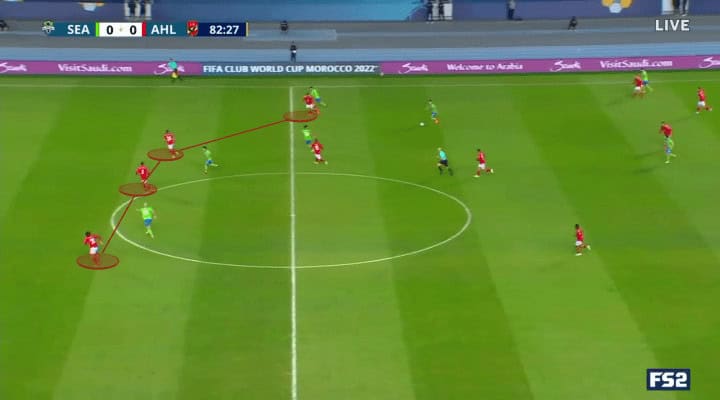
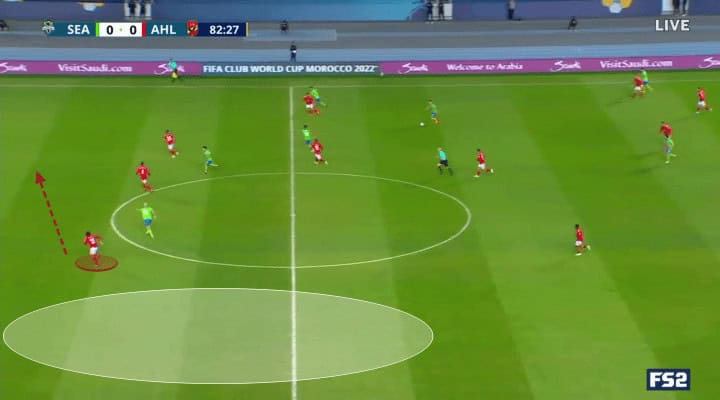
The left-back then chooses not to track the runner down the wing but opts to take up a position in a more central area. This is a poor decision as it leaves the Seattle winger completely free. With the ball having been played into the open space, the Al Ahly left-back has then tracked the runner further into a central area. This then leaves the opportunity for a relatively simple lofted pass into the Seattle player who is available.
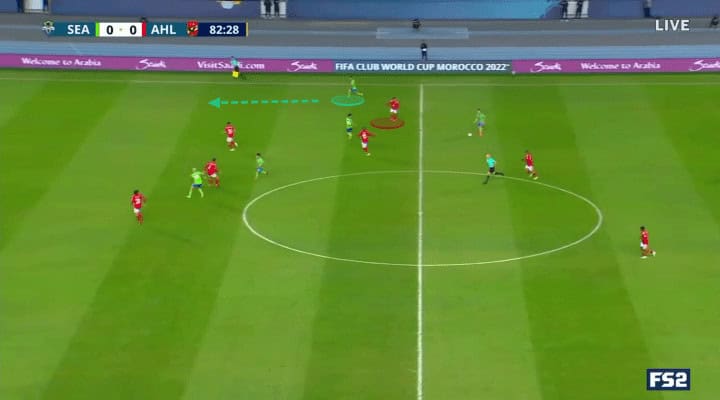
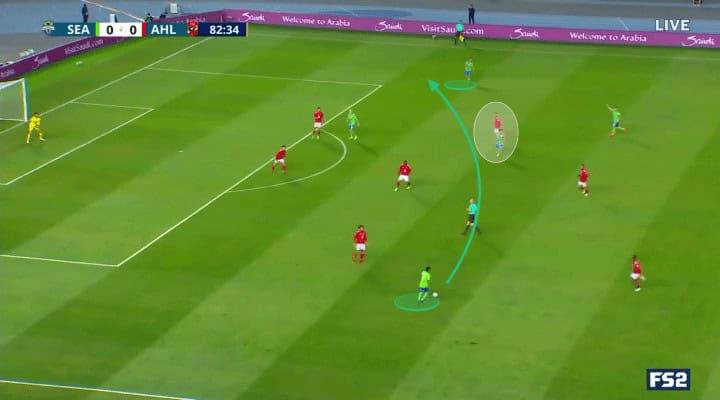
Conclusion
Marcel Koller is the man tasked with bringing trophies back to Al Ahly. With the best attack and defence in the Egyptian Premier League, it appears that the players are adapting well to his methods and implementing his style of play.
This tactical analysis has shown Marcel Koller has brought his own style to Al Ahly, a style that is paying dividends already, with the players fully committed, looking to renounce their dominance on the domestic and continental stages.
Using a structured attack and a high-pressing defensive system, Koller has found a way to play to Al Ahly’s strengths. The team is enjoying a stellar run of form that looks like it will continue. As the players continue to master Koller’s tactics, it is highly likely they will go from strength to strength.





Comments